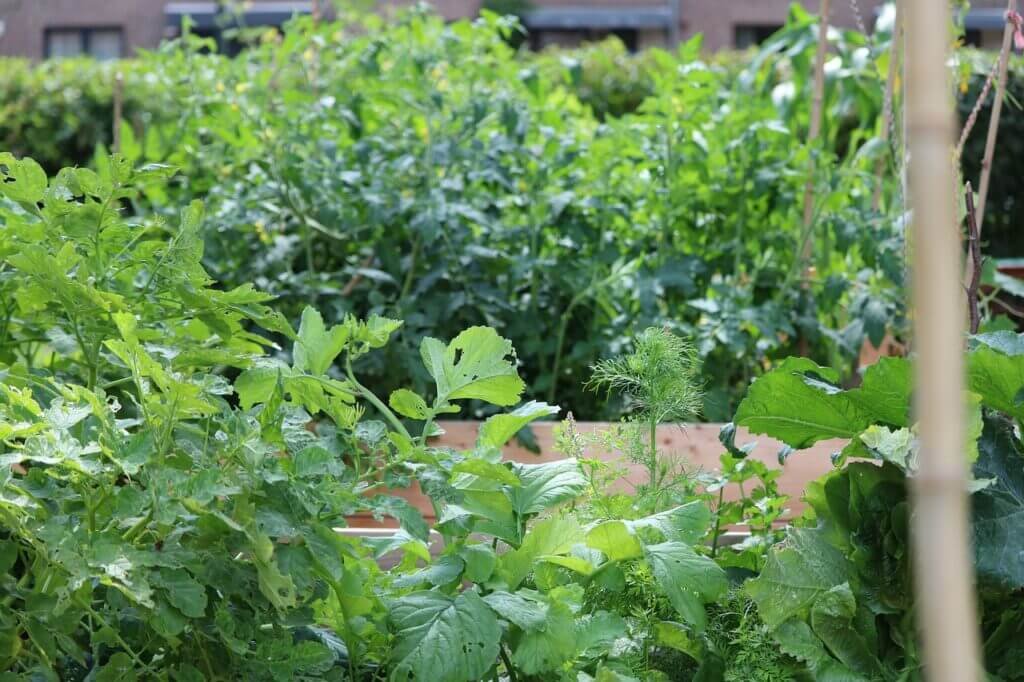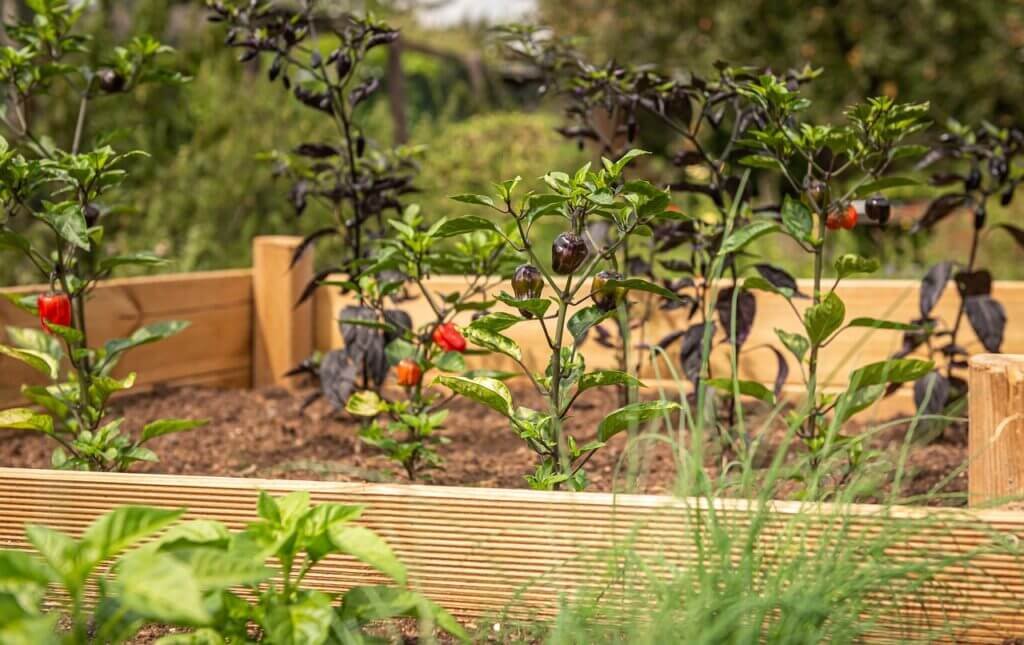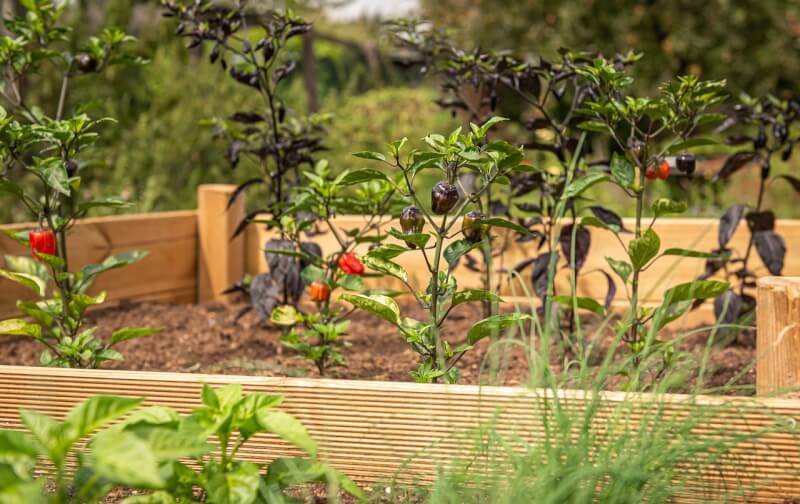Living in the heart of a bustling city often means limited space for gardening, but fear not, because raised beds are here to save the day! If you’ve ever wondered about the advantages of using raised beds in a city garden, look no further. These elevated planters offer a plethora of benefits, including improved soil quality, better drainage, and easier maintenance. So whether you’re a green thumb seeking a thriving urban oasis or simply looking to add a touch of nature to your concrete jungle, raised beds could be your answer. Get ready to discover how you can maximize your gardening potential in a limited space with the mighty raised bed!

Increased Accessibility and Ergonomics
Reduced bending and kneeling
Raised beds in a city garden provide a multitude of benefits, and one of the most significant advantages is increased accessibility and improved ergonomics. Unlike traditional ground-level gardens, raised beds are elevated off the ground, making it much easier for you to tend to your plants without constantly bending or kneeling. This is particularly beneficial for individuals with limited mobility or those who experience discomfort when performing tasks at ground level. By eliminating the need for excessive bending and kneeling, raised beds make gardening a more enjoyable and comfortable experience for everyone.
Easier for people with limited mobility
For those with limited mobility, gardening may often seem like a daunting task. However, with the introduction of raised beds in a city garden, this barrier is significantly reduced. The elevated height of the beds eliminates the need to crouch or stoop down, allowing individuals with mobility challenges to tend to their plants effortlessly. It promotes an inclusive gardening experience, ensuring that everyone, regardless of their physical capabilities, can enjoy the therapeutic benefits and the joy of growing their own plants.
Suitable for wheelchair gardening
Raised beds offer an excellent solution for wheelchair users who have a passion for gardening. The elevated design allows individuals in wheelchairs to comfortably reach the plants without having to strain or risk their stability. With the proper layout and consideration for wheelchair accessibility, raised beds enable wheelchair users to actively participate in gardening and experience the satisfaction of nurturing plants. This enhanced accessibility not only provides a therapeutic outlet but also promotes a sense of independence and inclusion for individuals with disabilities.
Improved Soil Quality
Optimal soil drainage
A key benefit of using raised beds in a city garden is the ability to have optimal soil drainage. The construction of raised beds allows for better control over the soil’s moisture levels, preventing waterlogging and excessive moisture buildup that can be detrimental to plant growth. In urban environments, where compacted or poorly drained soils are common, raised beds offer a solution by providing a space where the soil can drain freely, ensuring that plant roots are not constantly saturated. This improved drainage promotes healthy root development and reduces the risk of water-related diseases and rot, leading to thriving and vibrant plants.
Better aeration
In addition to improved drainage, raised beds also offer better soil aeration. The raised structure allows air to circulate more freely around the roots, preventing soil compaction and facilitating the exchange of gases between the soil and the atmosphere. This enhanced aeration is essential for root respiration and nutrient uptake, enabling plants to access the oxygen and nutrients they need for optimal growth. By promoting proper aeration, raised beds create an ideal environment for plants to thrive and reach their full potential, resulting in healthier and more robust vegetation.
Control over soil composition
Another advantage of using raised beds is the ability to have complete control over the soil composition. In urban environments, the soil may often be poor in quality, lacking essential nutrients or contaminated with pollutants. With raised beds, you have the opportunity to fill them with high-quality soil that is specifically tailored to meet the needs of your plants. By using a mixture of organic matter, compost, and other amendments, you can create a fertile soil blend that is rich in nutrients and free from any harmful substances. This control over soil composition ensures that your plants have the best possible conditions for growth, leading to healthier and more productive gardens.

Reduced Weed Growth
Less space for weed growth
One of the most frustrating aspects of gardening is dealing with relentless weeds that compete with your plants for resources. Raised beds offer a practical solution to this problem by reducing the space available for weed growth. With the enclosed and defined area of a raised bed, the weed seeds have less opportunity to establish themselves and spread. This not only minimizes the amount of time and energy spent on weeding but also reduces the competition for nutrients, water, and sunlight, giving your plants a better chance to thrive.
Easier weed management
In addition to limiting weed growth, raised beds also make weed management significantly easier. The elevation of the beds allows you to more comfortably access the entire garden space, making it easier to spot and remove any unwanted weeds. The defined borders of the raised beds also prevent the encroachment of weeds from surrounding areas, keeping your garden space neat and tidy. By reducing the effort required to manage weeds, raised beds provide a more enjoyable and hassle-free gardening experience.
Extended Growing Season
Warmer soil temperatures
Raised beds in a city garden offer the added benefit of extending the growing season. The elevated design of the beds allows the soil to warm up more quickly in the spring, creating a favorable environment for early planting and germination. The increased exposure to sunlight and the enhanced insulation provided by the raised sides of the beds help retain heat, allowing the soil temperatures to remain consistently warmer. This extended growing season gives you the opportunity to start planting earlier and enjoy a longer period of growth and abundance in your garden.
Protection against frost
Another significant advantage of raised beds is their ability to protect your plants from late-season frost. By lifting your plants off the ground, raised beds provide some insulation against cold temperatures, reducing the risk of frost damage to your delicate plants. Additionally, the extra warmth retained in the soil within the raised beds can help prevent the soil from freezing, ensuring that the roots remain unaffected. This protection against frost extends your gardening season even further and minimizes the risk of losing plants to sudden drops in temperature.
Ability to utilize season-extending devices
With raised beds, you have the flexibility to incorporate season-extending devices, such as row covers or cold frames, more easily into your gardening practice. These devices can help create a microclimate within the raised beds, offering added protection and insulation to your plants. By covering your raised beds during cooler weather or using them to support structures that provide shade during hotter months, you can manipulate the growing conditions and adapt to the needs of your plants throughout the year. This extended control over the growing environment ensures optimal conditions for your plants’ growth and allows you to experiment with a wider range of crops and varieties.

Enhanced Pest Control
Elevated height deters pests
Gardening in a city setting often comes with its fair share of pest challenges. Fortunately, raised beds can help deter certain pests due to their elevated height. The raised structure makes it more difficult for ground-dwelling pests, such as slugs or snails, to reach your plants, reducing their likelihood of causing damage. Additionally, the height of the bed provides a physical barrier that discourages larger pests, such as rabbits or rodents, from accessing your plants. This added protection against pests allows you to focus more on the joy of gardening and less on the ongoing battle against unwelcome visitors.
Easier application of pest control measures
In the event that pests do manage to find their way into your raised beds, their management becomes much more straightforward and targeted. With the plants at a convenient height, you have easier access to inspect them regularly for signs of pest activity, enabling you to address any issues promptly. The contained space of the raised beds also makes it easier to apply pest control measures, such as organic insecticides or physical barriers, directly to the affected plants without affecting surrounding areas. This precise application minimizes the use of chemicals and helps maintain a healthy and balanced ecosystem within your garden.
Better Water Management
Reduced water runoff
Effective water management is crucial in any garden, especially in urban areas with limited water resources. Raised beds offer an advantage in water management by reducing water runoff. The elevated structure of the beds prevents water from quickly flowing away, allowing the soil to absorb and retain moisture for longer periods. This helps maximize the utilization of water, ensuring that it reaches the plant roots where it is needed the most. By reducing water runoff, raised beds not only conserve this precious resource but also contribute to the overall sustainability of your gardening practices.
Controlled watering
With raised beds, you have greater control over the watering of your plants. The defined borders and contained space of the beds create a distinct area for each plant, preventing water from being wasted on non-target areas. This allows you to water directly at the plant’s root zone, minimizing water loss through evaporation and ensuring that the plants receive a sufficient and targeted water supply. Controlled watering not only helps conserve water but also promotes the efficient use of this vital resource, leading to healthier and more resilient plants.
Prevention of waterlogging
Overly compacted or poorly drained soil can often lead to waterlogging, which is detrimental to plant health. Raised beds can help prevent waterlogging by providing proper drainage, keeping excess water from accumulating around the roots. The construction of raised beds allows for the incorporation of drainage materials, such as gravel or sand, beneath the soil surface, ensuring that water has a clear path to escape. This prevents the roots from sitting in water for extended periods and reduces the risk of root rot and other water-related diseases. By promoting good water management practices, raised beds optimize the growing conditions for your plants and contribute to their overall vitality.
Increased Yield
Optimal plant spacing
Proper plant spacing is crucial for their growth and development, and raised beds can help you achieve optimal plant spacing more effectively. With the defined borders of the beds, you have clear guidelines for how far apart to space each plant, ensuring that they have enough room to grow without crowding each other. The controlled environment of raised beds also allows you to maximize space utilization while avoiding overcrowding, which can lead to stunted growth and increased competition for resources. By implementing appropriate plant spacing within the raised beds, you can optimize the growth and yield of your plants, resulting in a more productive and bountiful harvest.
Efficient use of soil nutrients
Raised beds enable you to make the most efficient use of soil nutrients. By focusing the nutrients in a confined space, you can ensure that they are readily available to the plants. With proper soil preparation and regular amendments, you can create a nutrient-rich growing medium that supports robust plant growth and development. In addition, the controlled environment of raised beds minimizes nutrient leaching, which can occur in traditional ground-level gardens due to excessive rainfall or overwatering. This nutrient management approach maximizes the uptake and utilization of essential elements by the plants, leading to higher yields and healthier crops.
Minimized competition for resources
In a city garden where space is often limited, raised beds provide a solution to the issue of resource competition among plants. The defined borders and contained space of the beds allow you to have complete control over what is planted where, eliminating the need for plants to compete for sunlight, water, and nutrients. By carefully planning and organizing your plants within the raised beds, you can ensure that each plant receives the necessary resources without being overshadowed or overwhelmed by neighboring plants. This reduced competition for resources promotes healthy growth, efficient resource utilization, and ultimately, increased yields in your city garden.
Improved Aesthetic
Enhanced visual appeal
The aesthetic benefits of using raised beds in a city garden cannot be understated. The clean lines and defined borders of the raised beds add structure and organization to your garden, enhancing its visual appeal. Whether you opt for a uniform design or experiment with different shapes and sizes, the raised beds provide a visually pleasing backdrop for your plants, creating a sense of order and beauty in your garden space. This enhanced visual appeal not only brings joy and satisfaction to the gardener but also serves as an attractive focal point in an urban setting, adding vibrancy and greenery to the surrounding environment.
Neater and organized appearance
Raised beds contribute to a neater and more organized appearance in your city garden. The contained space of the beds helps prevent the spreading and sprawling growth often seen in traditional ground-level gardens. This containment not only makes it easier to maintain and manage your plants but also gives your garden a more polished and tidy look. The defined borders of the raised beds act as natural dividers, keeping plants separate and preventing them from encroaching on one another. This organized and well-maintained aesthetic creates a sense of pride and accomplishment, making your city garden a pleasant space to relax and enjoy the beauty of nature.
Opportunity for Vertical Gardening
Utilization of vertical space
Raised beds open up opportunities for vertical gardening, allowing you to maximize space utilization and expand your planting options. The elevated structure of the beds provides a solid foundation for incorporating trellises, arbors, or other vertical supports. This vertical space can be used to grow climbing vegetables, vining plants, or even flowers, creating a lush and visually striking display. By utilizing vertical gardening techniques, you can make the most of your limited space and grow a wider variety of plants, enhancing the beauty and productivity of your city garden.
Creative design possibilities
With raised beds, you have the freedom to explore and express your creativity in designing your city garden. The elevated structure of the beds, combined with their defined borders, allows for various design possibilities. You can experiment with different bed shapes and sizes, arrange them in geometric patterns, or even incorporate multiple levels or tiers. This creative flexibility not only adds visual interest but also enables you to create pockets of different growing conditions within the garden, accommodating a diverse range of plant preferences and needs. By embracing the creative design possibilities of raised beds, you can transform your city garden into a unique and personalized oasis.
Protection from Contaminants
Barrier against polluted soil
In urban environments, the soil may often be contaminated with pollutants, such as heavy metals or chemicals, which can adversely affect plant health. Raised beds provide a barrier against such polluted soil, creating a safe and protected growing environment for your plants. By filling the raised beds with clean, uncontaminated soil, you can alleviate concerns about potential harm to your plants or the consumption of contaminated produce. This protective measure not only ensures the health and safety of your garden but also allows you to grow your own food with confidence, knowing that it is free from harmful substances.
Prevention of heavy metal uptake by plants
Raised beds also help prevent the uptake of heavy metals by plants. In urban areas, heavy metals can be present in the soil due to various industrial or environmental factors. When plants grow directly in contaminated soil, they have a higher risk of absorbing these harmful metals, which can then accumulate in their tissues. However, by using raised beds filled with clean soil, you create a physical barrier that reduces the direct contact between the roots and the contaminated soil. This barrier effectively minimizes the uptake of heavy metals, ensuring that your plants remain safe and free from potential toxins.
In conclusion, raised beds offer numerous benefits for a city garden. From increased accessibility and improved ergonomics to better soil quality and reduced weed growth, the advantages of using raised beds are plentiful. They provide an opportunity for an extended growing season, enhanced pest control, better water management, increased yield, improved aesthetics, and the possibility of vertical gardening. Additionally, raised beds offer protection against contaminants, ensuring a safe and healthy environment for your plants to thrive. Whether you are a seasoned gardener or just starting out, incorporating raised beds into your city garden can transform your gardening experience and yield bountiful results. So, roll up your sleeves, get creative, and start enjoying the countless benefits of using raised beds in your urban oasis.


